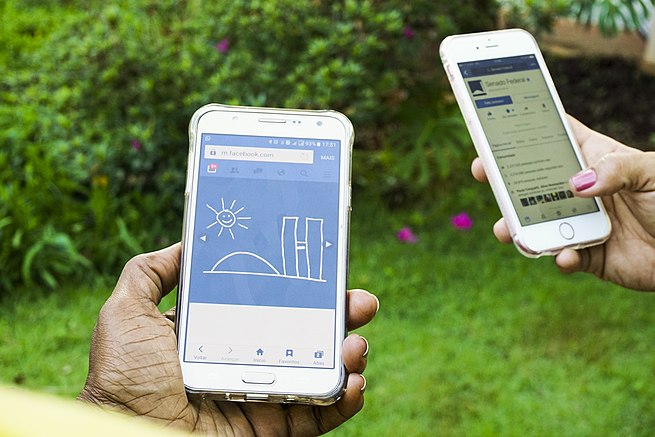
Main Difference
The main difference between Smartphone and Iphone is that the Smartphone is a multi-purpose mobile device and Iphone is a line of smartphones designed and marketed by Apple Inc.
-
Smartphone
Smartphones are a class of mobile phones and of multi-purpose mobile computing devices. They are distinguished from feature phones by their stronger hardware capabilities and extensive mobile operating systems, which facilitate wider software, internet (including web browsing over mobile broadband), and multimedia functionality (including music, video, cameras, and gaming), alongside core phone functions such as voice calls and text messaging. Smartphones typically include various sensors that can be leveraged by their software, such as a magnetometer, proximity sensors, barometer, gyroscope and accelerometer, and support wireless communications protocols such as Bluetooth, Wi-Fi, and satellite navigation.
Early smartphones were marketed primarily towards the enterprise market, attempting to bridge the functionality of standalone personal digital assistant (PDA) devices with support for cellular telephony, but were limited by their bulky form, short battery life, slow analog cellular networks, and the immaturity of wireless data services. These issues were eventually resolved with the exponential scaling and miniaturization of MOS transistors down to sub-micron levels (Moore’s law), the improved lithium-ion battery, faster digital mobile data networks (Edholm’s law), and more mature software platforms that allowed mobile device ecosystems to develop independently of data providers.
In the 2000s, NTT DoCoMo’s i-mode platform, BlackBerry, Nokia’s Symbian platform, and Windows Mobile began to gain market traction, with models often featuring QWERTY keyboards or resistive touchscreen input, and emphasizing access to push email and wireless internet. Since the unveiling of the iPhone in 2007, the majority of smartphones have featured thin, slate-like form factors, with large, capacitive screens with support for multi-touch gestures rather than physical keyboards, and offer the ability for users to download or purchase additional applications from a centralized store, and use cloud storage and synchronization, virtual assistants, as well as mobile payment services.
Improved hardware and faster wireless communication (due to standards such as LTE) have bolstered the growth of the smartphone industry. In the third quarter of 2012, one billion smartphones were in use worldwide. Global smartphone sales surpassed the sales figures for feature phones in early 2013.
-
Iphone
iPhone ( EYE-fone) is a line of smartphones designed and marketed by Apple Inc. All generations of the iPhone use Apple’s iOS mobile operating system software. The first-generation iPhone was released on June 29, 2007, and multiple new hardware iterations with new iOS releases have been released since.
The user interface is built around the device’s multi-touch screen, including a virtual keyboard. The iPhone has Wi-Fi and can connect to cellular networks. An iPhone can shoot video (though this was not a standard feature until the iPhone 3GS), take photos, play music, send and receive email, browse the web, send and receive text messages, follow GPS navigation, record notes, perform mathematical calculations, and receive visual voicemail. Other functionality, such as video games, reference works, and social networking, can be enabled by downloading mobile apps. As of January 2017, Apple’s App Store contained more than 2.2 million applications available for the iPhone.
Apple has released eleven generations of iPhone models, each accompanied by one of the eleven major releases of the iOS operating system. The original first-generation iPhone was a GSM phone and established design precedents, such as a button placement that has persisted throughout all releases and a screen size maintained for the next four iterations. The iPhone 3G added 3G network support, and was followed by the 3GS with improved hardware, the 4 with a metal chassis, higher display resolution and front-facing camera, and the 4S with improved hardware and the voice assistant Siri. The iPhone 5 featured a taller, 4-inch display and Apple’s newly introduced Lightning connector. In 2013, Apple released the 5S with improved hardware and a fingerprint reader, and the lower-cost 5C, a version of the 5 with colored plastic casings instead of metal. They were followed by the larger iPhone 6, with models featuring 4.7-and-5.5-inch (120 and 140 mm) displays. The iPhone 6S was introduced the following year, which featured hardware upgrades and support for pressure-sensitive touch inputs, as well as the SE—which featured hardware from the 6S but the smaller form factor of the 5S. In 2016, Apple unveiled the iPhone 7 and 7 Plus, which add water resistance, improved system and graphics performance, a new rear dual-camera setup on the Plus model, and new color options, while removing the 3.5 mm headphone jack found on previous models. The iPhone 8 and 8 Plus were released in 2017, adding a glass back and an improved screen and camera. The iPhone X was released alongside the 8 and 8 Plus, with its highlights being a near bezel-less design, an improved camera and a new facial recognition system, named Face ID, but having no home button, and therefore, no Touch ID. In September 2018, Apple again released 3 new iPhones, which are the iPhone XS, an upgraded version of the since discontinued iPhone X, IPhone XS Max, a larger variant with the series’ biggest display as of 2018 and iPhone XR, a lower end version of the iPhone X.
The original iPhone was described as “revolutionary” and a “game-changer” for the mobile phone industry. Subsequent iterations of the iPhone have also garnered praise. The iPhone is one of the most widely used smartphones in the world, and its success has been credited with helping Apple become one of the world’s most valuable publicly traded companies.
-
Smartphone (noun)
A mobile phone with more advanced features and greater computing capacity than a featurephone.
“mobile phone”
“iPhone”
